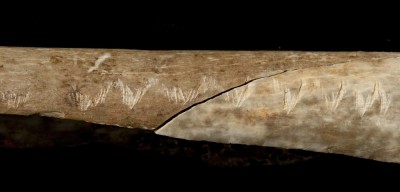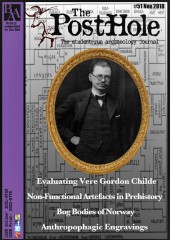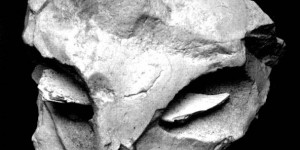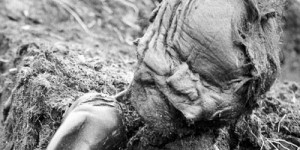Introduction
For Palaeolithic hunters and their prey, the arena of life and death was universal. The movements of the universe that affected beasts influenced early humanity equally, perhaps causing communities to view themselves as part of naturally occurring cycles of life and death. As such, these hunters acted as active participants in an environment not yet mitigated by technological advances associated with mankind. This concept manifests visually in numerous forms ranging from cave paintings, rock art, wearable objects, and funerary arrangements (Vialou 1998) Yet there are mysterious artefacts pertaining directly to human remains as material culture, which incorporate bone in what is often considered funerary ceremony, cannibalistic ritual, or a combination of the two (Bello 2017). Of particular distinction in this category is a human forearm found in Gough’s Cave of Somerset, England, dating to approximately 14,700 BCE (Bello 2015). This bone—a right radius classified as M54074 (Bello 2017)—bears not only evidence of butchery, but also enigmatic engravings that seem to bear no practical purpose. Whilst the general consensus regarding this artefact links it to some form of cannibalistic ritual (Andrews 2003, Balch 1947, Bello 2017, Cook 1991, Currant 1989), the overall purpose of this ascribed behavior has been given little consideration after the observation of cannibalism is made. In examining the engravings of this bone, the human-made decorative marks bear striking similarities to markings left on bones that were gnawed by ungulates (large hooved mammals). I suggest that these similarities are not incidental, but rather visual evidence of attempts made by the community of Gough’s Cave to symbolically rationalize acts of cannibalism by mimicking the actions of herbivores that were witnessed uncharacteristically feasting upon animal bones.
A brief archaeological history of the site is necessary to better articulate this hypothesis. Gough’s Cave received consistent attention in the public eye after its initial discovery in the 1880s, culminating in its retrofitting as a display space outfitted with electric lights (Currant 1989). In two of the most recent excavations undertaken by the Natural History Museum in 1986 and 1992, a previously unexamined area revealed the presence of numerous artefacts ranging from stone tools to human remains (Charles 1989). Of these human remains, 205 individual specimens were identified from an assemblage comprising primarily of fragments (of which only five anatomical refittings could be made for certain). Most strikingly, 58% of the postcranial bones are emblazoned with cut-marks associated with butchery, while 32% were cracked to extract marrow (Bello 2017).
Silvia Bello’s deliberations about the findings in Gough’s Cave have revealed a specific usage of human bone featuring markings both decorative and for de-fleshing, which she refers to as not merely emblematic of cannibalism but rather of a ritualistic quality welded to cannibalism (2015). Bello’s supposition is far from unreasonable, as human remains attributed to cultures of late Upper Palaeolithic Europe reveal consistent occurrences of funerary practices involving the removal of flesh from bone. In the French archaeological record alone, less than 10 complete skeletons were found compared to over 200 individuals whose skeletal record manifests disarticulated and fragmented, and, most strikingly, 40% of those 200 individuals bear evidence of de-fleshing (Bello 2017, 170). When viewed even in a strictly utilitarian perspective without consideration for potential ritualism, this evidence infers the practice of cannibalism since the de-fleshing process itself suggests the utilization of muscle tissue for food. Therefore, if the human bones in question at Gough’s Cave are indeed indicative of cannibalism, the questions remain of why this cannibalism occurred and why the engravings were necessary. In attempting to explicate my hypothesis regarding the decorative treatment of the human radius bone in Gough’s Cave, I rely on formal visual analysis of the bone’s various cut-marks, coupled with interpretations derived from the studies of scholars within seemingly disparate anthropological and scientific fields.
The Radius in Gough’s Cave
Visually, the bone itself is covered in a range of incisions and grooves falling into two broad categories according to the means by which the marks were made; those made as a result of de-fleshing, and those made intentionally for non-utilitarian purposes. Butchery marks consist of two clusters of linear incisions on the proximal end of the anterior side and the distal end of the posterior side, a crack along the length of the bone on the anterior side, and a scattering of human teeth-marks across the proximal end; engraved marks only occur on the anterior side of the radius, nearer to the proximal end rather than the distal (Bello 2017, 2-3). Electron microscope photography reveals distinct differentiations between engraving and filleting, with the former being denoted by single slices and the latter evidenced by less precise sawing patterns (Bello 2017, 4-10). Of these proliferate marks, the engravings are noteworthy in that they form a row of v-shaped arrangements.
Also of note is that these engravings only occur on parts of the bone originally devoid of muscle. In contrast, the two clusters of butchery cuts appear along attachment points for the extensor pollicis brevis and flexor pollicis longus muscles, lending credence to Bello’s assertion that these were made during the process of de-fleshing rather than for decorative purposes. Two other indications of cannibalistic treatment imposed on this bone are human teeth-marks and a crack running lengthwise along the radial shaft, which was likely a result of percussive damage made to access marrow within the bone (Bello 2017, 13). While the percussive crack aligns with no musculature, the teeth marks occur throughout the area of the pronstor quadratus muscle, implying manual removal of muscle tissue without obvious tool-usage. In this context, the presence of engravings only on areas without evident muscle attachment dismisses these engravings as utilitarian.
While this wealth of visible evidence supports Bello’s claim of cannibalistic intent, the purpose of the decorative engravings remains difficult to ascertain. However, the work of ethno-archaeologists and ethnographers may shed light on potential purposes. For example, Erica Hill examines the treatment of butchered seal bones in maintaining sufficient prey for the coming hunting seasons in Yupiit and Inupiat cultures of Southeast Alaska (2012). Numerous sites throughout the Nelson and Nunivak Islands contain middens of seal bone in the archaeological record, often placed at the periphery of human inhabitance bordering pure wilderness (Hill 2012, 48-49). By examining extant regional ethnography, Hill explains these assemblages as evidence of ritualistic behaviours rather than simple middens of post-butchery waste material, asserting that strategically-placed burials of butchered seal bones represent dynamic points of contact between the hunters and the prey (2012, 48).
Such ethnographic data suggests a functional purpose for prehistoric hunting societies to form some manner of metaphysical, inter-species dialogue in that the specific treatment of butchered carcasses was intended to ensure productive hunting seasons. These middens are markedly similar to the assemblage of modified human remains in Gough’s Cave, and as such speak to a level of agency on the part of the artist in transforming an otherwise inanimate objects into something that fundamentally alter the movements of the world (Gell 1998, 68).
Deliberate imitation?
Regarding the bone at Gough’s Cave, the engravings in question bear similar patterns to naturally occurring marks on animal bone made by the chewing process of other animals. Unexpectedly, grooves found on bones gnawed upon by ungulates bear significant similarity to the engraved human radius in question. The appearance of these marks on animal bone is surprising in and of itself, given the herbivorous nature of ungulates. However, modern-day ungulates have been observed in this act, and the bones they gnawed upon have been examined to determine patterns made by the process (Bowyer 1983, Hutson 2013). Jarod Hutson believes that these animals derive essential minerals—largely calcium—from gnawing bones, thereby filling any potential nutritional gaps occurring in a predominantly vegetarian diet (2013, 4139). Most importantly, the patterns made on bone consequent of this act of herbivorous osteophagia are most significant to my argument. Hutson describes both the resultant patterns and how they are made resulting from herbivores chewing along the long axis of bones—appearing to the onlooker much like the way a cigar is held in someone’s mouth—leaving v-shaped marks along the length of the bone (2013, 4140).
These descriptions of v-shaped grooves occurring in perpendicular orientation to the length of the chewed-upon bone bear similarities to the engraved markings on the Gough’s Cave radial bone. Hutson provides visual examples in which gnaw-marks made by various ungulates bear commonality in the manifestation of distinctly v-shaped grooves (2013, 4145). Also of note, this gnawing process not only removes any remaining musculature from the bone, but also has the side-effect of polishing it. Hutson recalls a scenario in which a giraffe was observed in the act of osteophagia, further explicating the chewing process earlier described as well as the manner in which bone is cleaned and polished in the process (2013, 4140).
This behavior is not unique to giraffes, as evidenced by Hutson’s catalogue of such observed behaviors including various species of deer and antelope—species that are believed to be particularly drawn to osteophagia for increased calcium intake during periods of antler-growth (2013, 4140–4143). In addition, many of these animals were widespread in pre-Holocene Europe compared to contemporary populations that seem to thrive in greater numbers within ecosystems closer to the equator (Straus 1988, 150). With this in mind, the landscape of Palaeolithic England was profuse with ungulates that could very likely have engaged in the same osteophagic behaviors seen in modern-day species. This suggests a greater likelihood of Palaeolithic hunters seeing prey animals engaging in a form of inadvertent cannibalism during the hours spent stalking. As such, the parallel between ungulates feeding on animal bone and Palaeolithic human cannibalism may become clearer. Perhaps these inhabitants saw no dissimilarity between those acts and cannibalistic acts of their own. By mimicking the practice of polishing and engraving bones, these early humans did not think of themselves as dissimilar from the beasts that inhabited their same environments.
While the presence of animal remains in the archaeological record have typically been relegated to their function sources of nourishment or beasts of burden for human usage, efforts have been made in recent years by archaeological scholars to pay attention to relational ontologies between humanity and animals (Hill 2013, 2014; Willersley 2004). Particularly, the relationship between hunters and prey have been examined in part by acknowledging ties that exist between oral histories and traditional narratives of extant indigenous cultures to those of prehistoric humanity. Erica Hill suggests that “[a] more inclusive prehistory of human-animal relations recognizes the contingent nature of our engagement with animals and embraces the interpretive possibilities of animal personhood (2013, 127).”
The concept of personhood in this case denotes an ontological relationship between early humanity and fauna that suggests animals were considered to be part-person, if not alternate forms of humanity (Willersley 2004, 633–634). As such, the ritual artist of Gough’s Cave visually evokes the grinding teeth of giant Palaeolithic deer in preparing a fallen cohabitant while the same deer unintentionally evokes the ritual artist in scavenging bones. Engraved bones may not merely represent cannibalism, but perhaps Palaeolithic humanity’s awareness of the non-human society they inhabited, and the ability to convey their cognizance through visual means.
Bibliography
- Andrews, P., and Fernández-Jalvo, Y. (2003). Cannibalism in Britain: Taphonomy of the Creswellian (Pleistocene) Faunal and Human Remains from Gough’s Cave (Somerset, England). _Bulletin of the Natural History Museum of London (Geology) _, 58, 58–81.
- Balch, H. (1947). Cheddar, Its Gorge and Caves. Bristol: John Wright and Son.
- Bello, S., Parfitt S., Stringer C., and Wallduck, R. (2017). An Upper Palaeolithic Engraved Human Bone Associated with Ritualistic Cannibalism. PLOS One. [Online] Available at:
https://doi.org/10.1371/journal.pone.0182127 [Accessed 3 March 2018]. - Bello, S., Saladié P., Cáceres, I, Rodríguez-Hidalgo, A., and Parfitt, S. (2015) Upper Palaeolithic Ritualistic Cannibalism at Gough’s Cave (Somerset, UK): The Human Remains from Head to Toe. Journal of Human Evolution, 82, 170–189.
- Bowyer, R. (1983). Osteophagia and Antler Breakages Among Roosevelt Elk. California Fish and Game, 69, 84–88.
- Charles, R. (1989). Incised Ivory Fragments and Other Late Upper Palaeolithic Finds from Gough’s Cave, Cheddar, Somerset. Proc Univ Bristol Spelaeol Soc, 18, 400–408.
- Cook, J. (1991). Preliminary Report on Marked Human Bones from the 1986–1987 Excavations at Gough’s Cave, Somerset, England. In N. Barton, A. Roberts, and D. Roe (Eds). The Late Glacial in North West Europe. York: CBA Research Report, 77, 160–168.
- Currant, A., Jacobi, R., and Stringer, C. (1989). Excavations at Gough’s Cave, Somerset 1986–7. Antiquity, 63(238), 131–136.
- Gell, A. (1998). Art and Agency: An Anthropological Theory. Oxford: Oxford University Press.
- Hill, E. (2013). Archaeology and Animal Persons: Toward a Prehistory of Human-Animal Relations. Environment and Society: Advances in Research, 4, 117–136.
- Hill, E. (2012). The Nonempirical Past: Enculturated Landscapes and Other-Than-Human Persons in Southwest Alaska. Arctic Anthropology, 49(2), 41–57.
- Hutson, J., Burke, C., and Haynes, G. (2013). Osteophagia and Bone Modifications by Giraffe and Other Large Ungulates. Journal of Archaeological Science, 40, 4139–1419.
- Straus, L.G. (1988). “Hunting in Late Upper Palaeolithic Western Europe.” In M. Nitecki and D. Nitecki, (Eds). The Evolution of Human Hunting. Berlin: Springer Nature, 147–176.
- Vialou, D. (1998). Prehistoric Art and Civilization. New York: Abrams Discoveries.
- Willerslev, R. (2004). Not Animal, Not Not-Animal: Hunting, Imitation and Empathetic Knowledge Among the Siberian Yukaghirs. Journal of the Royal Anthropological Institute, 10(3), 629–652.







